The history of fashion has always been more than just clothing; it is a reflection of society, culture, and history. From the roaring twenties to the grunge era of the 90s, fashion has played a pivotal role in shaping and reflecting world events, trends, and attitudes.
In this article, we will take a journey through the 1920s-1940s, exploring the evolution of fashion and its influence on the world around us.
1920’s
Social and political upheavals that came about after the First World War caused significant fashion changes in women’s clothing in the 1920’s. There was a general relaxation of social rules after the horrors of the First World War, when thousands of young men died fighting in the trenches.
Gone were the ‘health corsets’ of the early 1900’s that created the fashionable S-shape silhouette with corsets that removed pressure from the abdomen, and resulted in the bust being pushed forward and the hips pushed back. Gone was the modesty emphasized with dresses covering the body from neck to floor and long sleeves covering the arms.
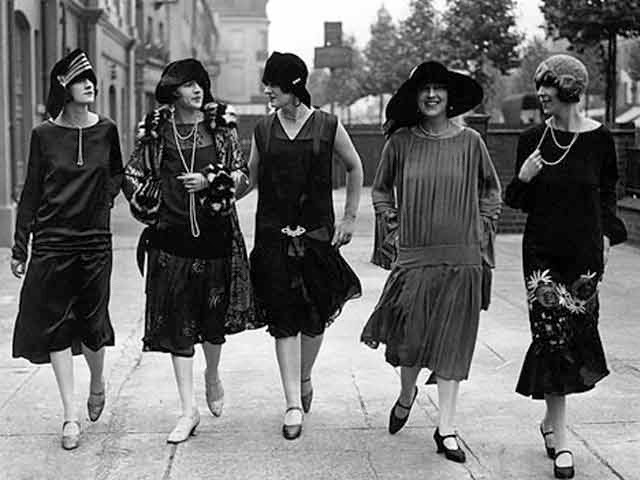
The daring fashion of the 1920’s created simple, loose lines for women with varying hemlines and dropped waists. There were also flashes of androgyny, with the use of ties, high-waisted trousers, hats, and tailored dresses that resembled suits. The Roaring Twenties featured the flapper-look, also known as la garçonne, or “boy” in French. Evening dresses were covered with rhinestones, layers of fringe, or rich embroideries with Art Deco patterns.
One Parisian fashion designer’s clothes encouraged elegance, individuality, and liberation for women: Gabrielle ‘Coco’ Chanel. Chanel revolutionized the way women wore clothes, and in doing so, challenged women to live by their own rules.
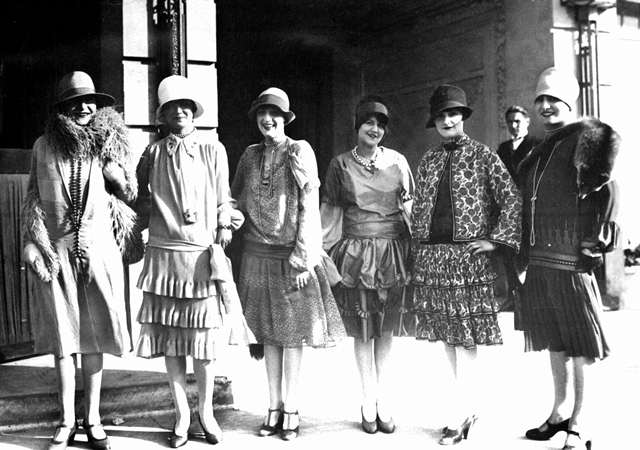
It was not until Coco Chanel designed the first trousers for women that ladies had an option other than dresses.
The stock market crash in 1929, which caused the Great Depression, sobered the nation.
1930’s
The androgynous, frivolous, daring look of the 1920s was out during this difficult time. Clothes became more conservative and feminine. Skirts became longer. Ready-to wear clothes and cheaper man-made materials became popular. A phenomenon among children’s clothing in the US, especially for girls, was the flour-sack dress.
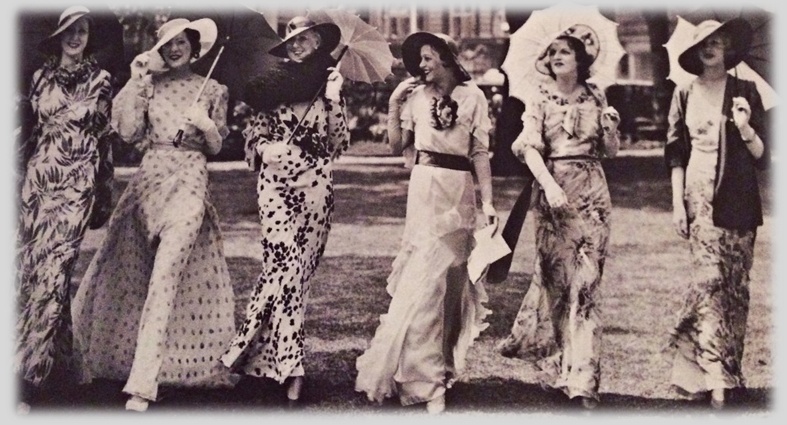
The 1930’s fashion saw a profound influence from films and specifically Hollywood. Men’s, women’s, and children’s styles were based on fashions seen on the movie screen. Stars like Clark Gable, Jean Harlow, and Shirley Temple are among the many who directly influenced fashion. For women, the fashionable silhouette was a slender, elongated torso with widening shoulders. Though the lines were simple, the overall effect was one of complete sinuous femininity with a natural waist and skirts flaring out slightly at the ankle.
World War II meant rationing and shortages which bred creativity. The shortage of fabric caused the popularity of the two-piece suit known as a Victory or Utility suit. Women could mix and match skirts, blouses, and jackets for a new outfit every day. Even after the war, the suit remained popular due to its comfort and practicality.
1940’s
Undergarments or foundation garments were the soul of 1940s fashion. They created the hourglass shape with smooth lines that were critical to ’40s fashion. They were also very uncomfortable. Girdles were the worst offenders. They looked like granny panties but with much tighter, flatter fronts that sucked in every belly bump and lump. Bras were large with full back coverage. They encouraged a natural rounded shape. A full slip was usually worn over the underwear to keep the shape smooth. If a woman was not naturally an hourglass shape, the clothes were designed to help her achieve the look.
Being put together, cheerful, and practical was the job of women during WWII. 1940s fashion accessories such as hats, gloves, handbags, and jewelry completed an outfit, while natural makeup with bright red lips painted a happy face during difficult times. Shoes – peep-toe heels, loafers, Oxfords, and wedge sandals, seamed stockings or socks. Hats, turbans, head scarves, snoods, and flower clips topped women’s heads. The two-piece bikini debuted.
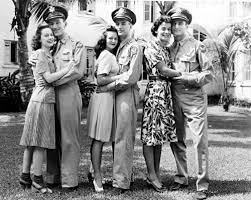
Although two-piece bathing suits were being used by women as early as the 1930s, the bikini is commonly dated to July 5, 1946, when, partly due to material rationing after World War II, French engineer Louis Réard introduced the modern bikini. The United States had detonated two nuclear bombs at the Bikini atoll, an island in the central Pacific Ocean. This event, of course, was big news around the world. A year later, a scanty two-piece bathing suit called a bikini, came on the market.
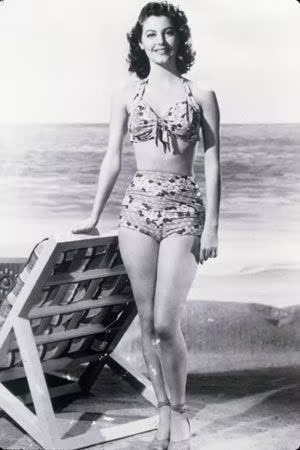
Trademark-hats of the 1940s: The first was the beret, a one-piece round, flat, French-inspired hat that sat directly on top or angled off to the side. The next hat was the turban, a piece of fabric wrapped around the head and decorated with flowers, feathers or jewels. Small hats with flat brims with veils were another trademark style. They were not practical for sun protection, merely decorative. The ladies’ fedora hat was one of several felt hats that took inspiration from men’s hat styles.
Pants or trousers were primarily a menswear item up until the 1940s. Women working in factories needed safe clothing that wouldn’t snag in machinery. At first, women just wore men’s pants. Later manufacturers made pants for women, although they still looked very masculine. They were very high waisted, button or zipper down the side and had full legs with wide cuffs at the bottom. They were made of cotton, denim, or wool blends.
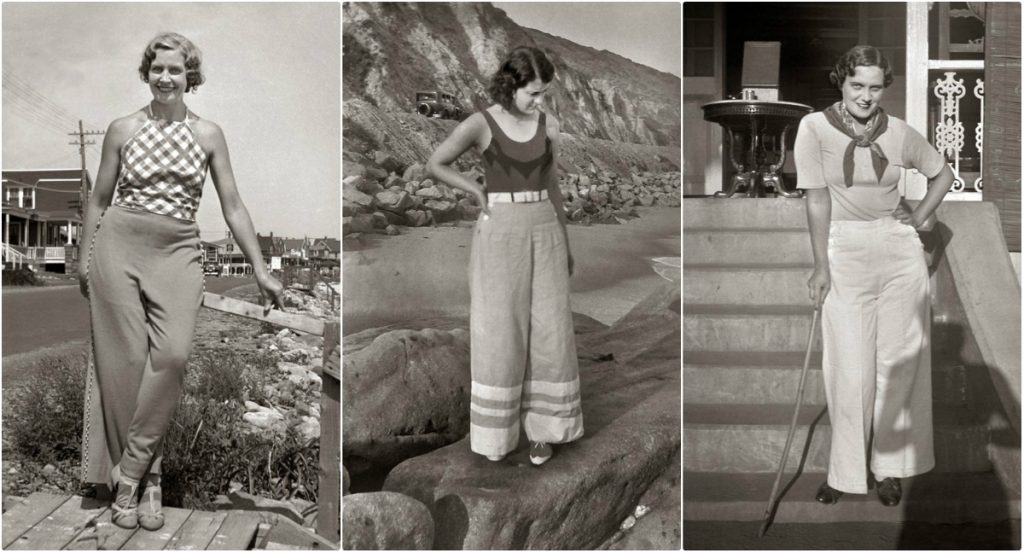
Overalls and coveralls were another workwear-turned-sportswear option. Made of blue denim or sturdy cotton, they have become a symbol of the 1940’s Rosie the Riveter in the United States and In the United Kingdom, the Landgirl wore them for farming.
Women’s clothes also took on a masculine militant look with the invention of shoulder pads. Every dress, blouse or jacket was fitted with shoulder pads that extended just past the edge of the shoulder. This made for a boxy or square neckline and shoulder angle. Sleeves were often puffed up a bit with gathers at the top and extended down to just above the elbow.
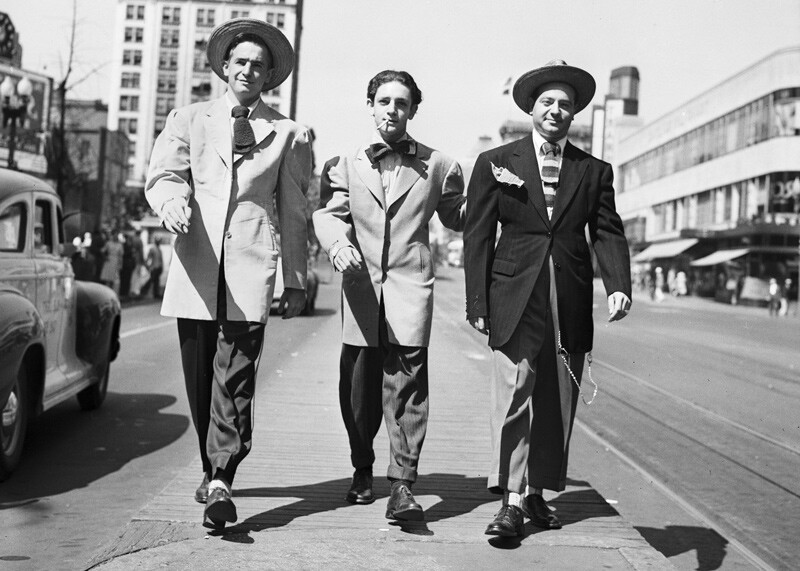
Later in the 1940s, more fabric could be used and more fabric choices were available. In order to forget the depressing war, women embraced colorful patterns with contrasting trims. Fabric material was usually rayon, a newer synthetic invention. America cotton was also a favorite for house dresses. The material was light and airy. Stiffer, wool-like fabrics were used on suits and work wear.